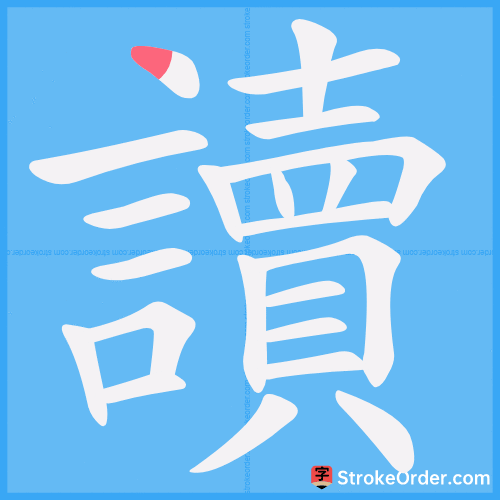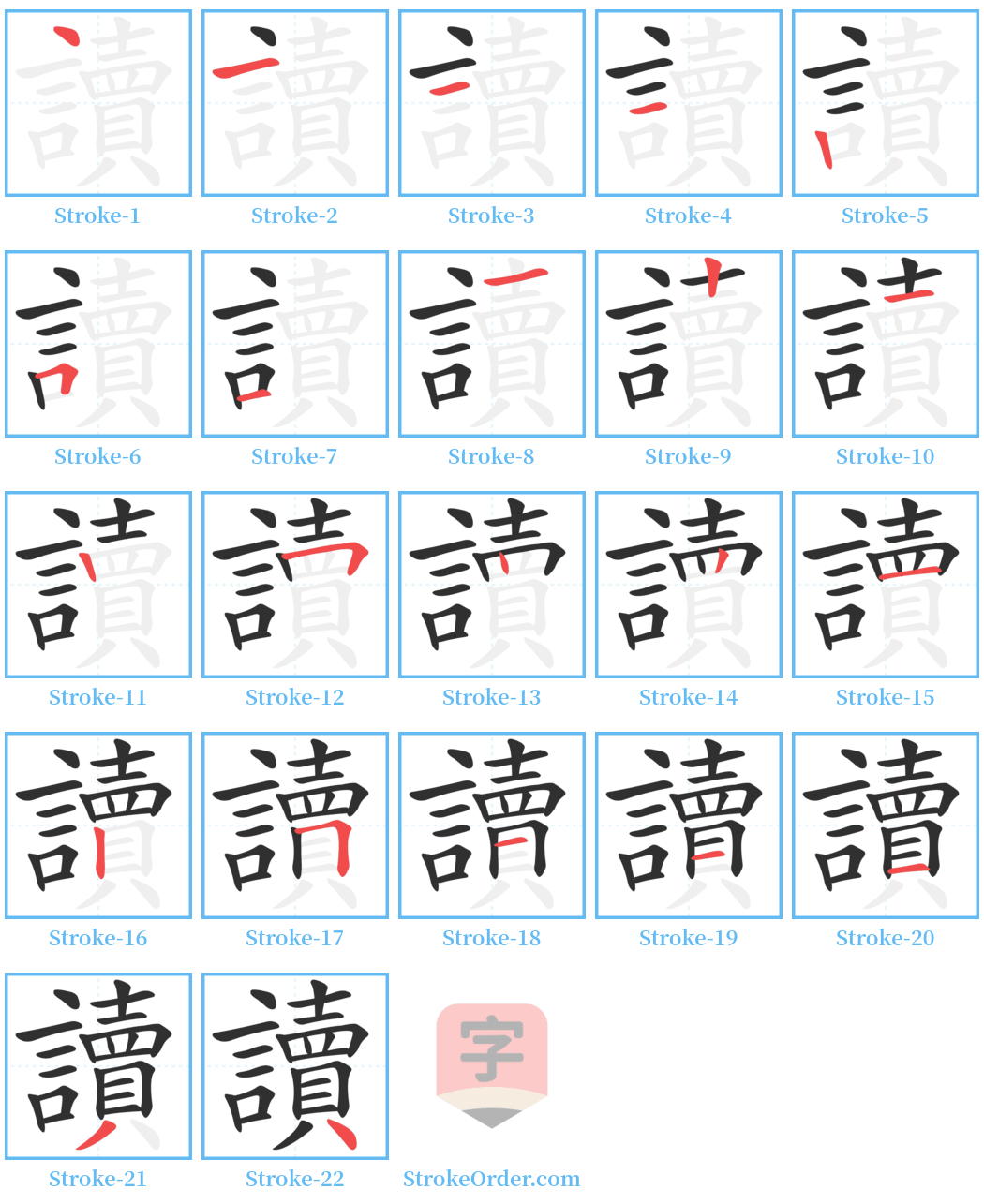讀 Stroke Order
Animated Stroke Order of 讀

Stroke Order Diagrams for 讀

Step-by-Step Handwriting Guide for 讀

Learn to Write Chinese Characters with Video Tutorials
Watch the video of writing the Chinese character "讀", learn the correct stroke order (笔顺) of the character "讀", and master the standard way of writing the character "讀".
Free Printable Handwriting Practice with Stroke Order: 讀
Printable Writing Practice Worksheet of "讀" in Portrait Orientation (Tian Zi Ge)

Printable Writing Practice Worksheet of "讀" in Landscape Orientation (Tian Zi Ge)

Information of 讀
Pinyin
dú、 dòu
Radical
言
Strokes
22 strokes
Usage
★★★
Definition
comma / phrase marked by pause, to read / to study
讀
Pronunciation: dú (verb)
【Primary Meaning】: to read books
1. 依照文字念: Reading according to the text. Example phrases include: 讀數 (reading numbers), 讀經 (reading scriptures), 讀書 (reading books), 宣讀 (to announce), 朗讀 (to read aloud), 範讀 (to read as a model).
2. 看書,閱覽: To read and browse books. Example phrases include: 閱讀 (to read), 速讀 (speed reading), 默讀 (silent reading), 讀者 (reader).
3. 求學: To attend school.
4. 字的念法: The pronunciation of characters. Example phrases include: 讀音 (pronunciation), 讀破 (to spell out).
讀
Pronunciation: dú (noun)
1. 文體名。屬於題跋一類。用以記心得於書後,以備遺忘: A style of calligraphy, belonging to the category of postscript; used to record insights after reading for future reference.
2. 姓: A surname.
3. 另見 dòu (also see 逗).
讀
Pronunciation: dú (verb)
1. 籀書,抽釋理解書的意義: To chant and interpret the meaning of a book ([En.] chant).
Reference:
- 《說文》: 讀, 誦書也 (To read is to chant a book.)
- 《公羊傳·定公元年》: 主人習其讀而問其傳 (The master learned to read and asked about the transmission.)
- 《孟子》: 讀其書 (To read his book.)
- 《論衡·談天》: 相隨觀讀,諷述以談 (To observe and read together, to recite and converse.)
2. 閱讀: To read ([En.] read).
Reference:
- 晉· 陶潛《五柳先生傳》: 好讀書,不求甚解 (Likes to read books without seeking deep understanding.)
- 清· 袁枚《黃生借書說》: 其讀書也必專,而其歸書也必速 (When reading, one must be focused, and when returning books, one must be prompt.)
- 邯鄲淳《笑林》: 楚人貧居,讀《淮南方》 (The poor people of Chu read "Huainanzi.")
3. 說: To speak ([En.] speak; talk).
Reference:
- 《廣雅·釋詁二》: 讀, 說也 (To read is to speak.)
- 《莊子·則陽》: 號而讀之也 (To call out and read it.)
4. 上學: To attend school ([En.] attend).
Example phrases: 讀大學 (to attend university), 走讀 (to study while commuting), 半工半讀 (half work and half study).
讀
Pronunciation: dòu (noun)
1. 語句中的停頓: A pause in a sentence. In ancient times, while reading texts, short pauses were called "讀", longer pauses were called "句," now marked by commas. Also written as "逗" ([En.] pauses in reading aloud).
Reference:
- 唐· 韓愈《師說》: 句讀之不知,惑之不解 (Not knowing how to distinguish pauses confuses understanding.)
- 晉· 何休《春秋公羊註疏序》: 援引他經,失其句讀,以無爲有 (Quoting another scripture without proper pauses leads to misunderstanding.)
2. 另見 dú: Also see 讀.